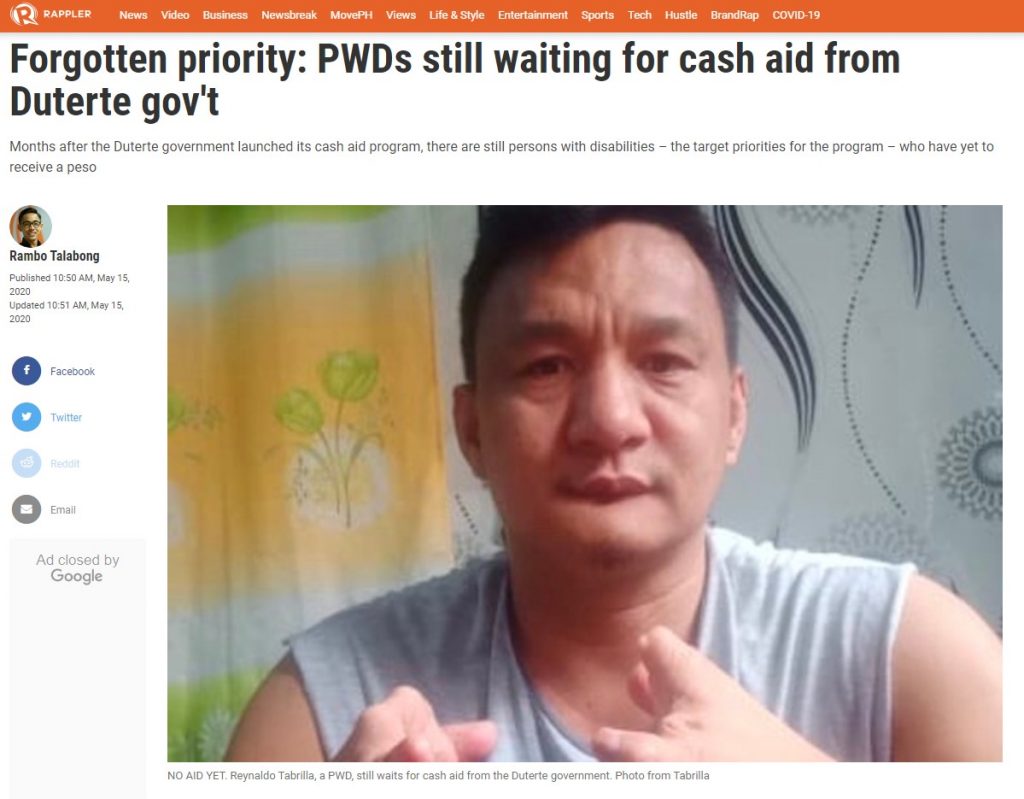PWDs in media: Overlooked and left out

LIKE MANY poor Filipinos, persons with disabilities (PWD) are among the most affected by the COVID-19 pandemic. They, like everyone else, have suffered the brunt of the inefficiency and lack of resources of the government’s response to the health crisis.
CMFR cheers Rappler and Philstar.com for their focus on the problems faced by PWDs during the crisis. Their situation had not captured most of the media’s attention; and as the reports of the two organizations revealed, PWDs feel they had been left out of the picture.
Rappler on May 15 zeroed in on the stories of four PWDs from four different cities who all experienced difficulties in availing of government assistance. These PWDs have congenital anomalies in their body, have missing or deformed limbs, or have suffered the physical side effects of diseases like polio. They suffered more from the hardship of being told to wait for prolonged periods of time without any assurance that they would receive the much needed cash aid, or without knowing if they were ineligible because of inadequate documents or qualifications.
As the account showed up the discrepancies in the distribution of government’s emergency assistance, it revealed how these affected PWDs – a sector of society that clearly needs special assistance. As Rappler noted, all the PWDs ask “is that they not be forgotten.”
Philstar.com’s report on May 20 heard the same plaint from PWDs – the feeling of “being left behind.” Philstar.com drew the institutional perspective from Luzon-based networks and organizations working on the issues of the disabled, whose representatives lamented the difficulties brought about by the lockdown and the seeming lack of adequate attention to the needs of their sector. As the report aptly put it, PWDs don’t have many choices, and the prevailing situation pushes them to “risk aggravating their existing conditions” without healthcare and medication.
The report also reviewed some of the issues that have hounded the rollout of emergency subsidies under the social amelioration program (SAP): poor information dissemination from the DSWD and local government units, along with the absence of up-to-date government data. Philstar.com pointed out that the last known census on the disability community in the Philippines was done in 2010, which counted only 1.44 million PWDs nationwide. A working database would have helped to establish a more accurate count and made a lot of difference in securing their rights, PWD Philippines told Philstar.com.
Mateo Lee Jr., deputy executive director of the National Council for Disability Affairs (NCDA), an attached agency under the DSWD, told Philstar.com that “the government is making ways so that PWDs will be included the next time aid is given.”
As difficult as the COVID-19 situation is, how can a government leave behind those who are already held back by disability? (CMFR previously cheered a number of reports that also looked into how different sectors have been affected by the COVID-19 crisis. See: “Amid the pandemic: News that remembers the forgotten”)
Leave a Reply